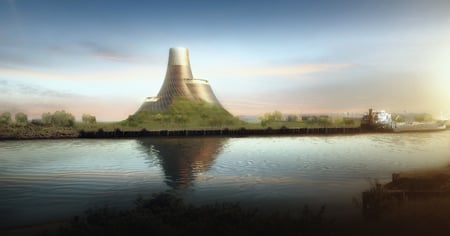For a chemical engineer, I spend a lot of time with architects. I enjoy acquainting myself with people from different backgrounds who can provide a refreshing look to my own engineering profession. This usually means that outside of work, I am surrounded by a sea of architecture: from the buildings to the people who design them, and choose to learn more about architecture through friends or social events designed to raise awareness of green building issues. In Seattle, it seems that building professionals and affiliated events are numerous, though development itself is not in full force due to an unpredictable economy.
As a Leadership in Energy and Environmental Design (LEED) accredited professional (AP), I am otherwise constantly thinking about green and sustainable building design principles. LEED is a rating system and certification program administered through the US Green Building Council (USGBC) that serves as a marker for what makes buildings "green." Interestingly, it's great to have a hand in the architecture and building world, because the chemical engineering and architectural connection is a perfect combination of disciplines to tackle sustainable design and green building problems from a comprehensive and all-encompassing perspective in any industry or field.
An Example: The BEI Teesside Project
Take, for instance, the BEI-Teesside project in consideration for Stockton-on-Tees, Teesside, United Kingdom. An architect friend of mine introduced me to an article about a new 49 MWe biomass-fuelled power plant project for which a planning application has been submitted by Bio Energy Investments Ltd (BEI). The project will be built on a Brownfield site on the bank of the River Tees, and the fuel will be provided by palm kernel shells. No farm land will be diverted from food production to the production of fuel, and it is intended to derive solely from palm oil plantation leftovers. Furthermore, no fuel will reach the facility by truck or land--the river location allows for fuel to arrive entirely by ship. The power plant building will provide electricity to over 50,000 homes.
BEI-Teesside has chosen British designer Thomas Heatherwick and his team to house the power plant in a building that is nothing short of literally "green." The uniqueness of this idea is captivating. Thomas Heatherwick, founder of Heatherwick Studio, has said:
"Over recent decades we have neglected the cultural contribution industrial infrastructure can make to our society. Power generation is now one of the most hotly debated aspects of our political futures. With growing urbanization and more power stations being built at a local level, we need to find new ways to incorporate these buildings into our lives and make them of benefit to society."
The benefit of the architectural hand in an engineering-heavy project is that sustainable process design is not limited exclusively to the effectiveness of renewable energy generation of the plant, but also encompasses the importance of site and building structure in fully achieving a sustainable approach to power production.
As engineers, should we confine ourselves to solving problems exclusively through a traditional engineering approach? What do you think of the interaction between an architectural design problem confronted with a chemical engineering design problem? Can an interdisciplinary view of sustainability resolve many more environmental concerns our society currently faces? Do you know of other examples in which the role of the chemical engineer is clearly redefining itself in collaboration with an entirely different discipline or profession? One lesson is clear: green building (among many other fields) is not only for the architects.
Related articles by Zemanta
- Office Depot Announces Major Environmental Initiative to Open "Green" Retail Stores (eon.businesswire.com)
- LEED, BIM and Smart in the Land of Green Opportunity (constructionlawva.com)


